- News
- Reviews
- Bikes
- Accessories
- Accessories - misc
- Computer mounts
- Bags
- Bar ends
- Bike bags & cases
- Bottle cages
- Bottles
- Cameras
- Car racks
- Child seats
- Computers
- Glasses
- GPS units
- Helmets
- Lights - front
- Lights - rear
- Lights - sets
- Locks
- Mirrors
- Mudguards
- Racks
- Pumps & CO2 inflators
- Puncture kits
- Reflectives
- Smart watches
- Stands and racks
- Trailers
- Clothing
- Components
- Bar tape & grips
- Bottom brackets
- Brake & gear cables
- Brake & STI levers
- Brake pads & spares
- Brakes
- Cassettes & freewheels
- Chains
- Chainsets & chainrings
- Derailleurs - front
- Derailleurs - rear
- Forks
- Gear levers & shifters
- Groupsets
- Handlebars & extensions
- Headsets
- Hubs
- Inner tubes
- Pedals
- Quick releases & skewers
- Saddles
- Seatposts
- Stems
- Wheels
- Tyres
- Health, fitness and nutrition
- Tools and workshop
- Miscellaneous
- Buyers Guides
- Features
- Forum
- Recommends
- Podcast
TECH NEWS
First ride: Cannondale Synapse Hi-Mod + Video
Two-wheel drifting through the corner of a rutted and gravel strewn road, clouds of white dust billowing up around me and stones pinging off the granite wall just a couple of feet to me right, I instantly know this new Cannondale Synapse Hi-Mod is something special.
Cannondale’s new Synapse made its first public appearance when some of the Cannondale Pro Cycling team raced it at the Strade Bianche race in Tuscany a few weeks back - a tough race that takes in rough roads cut through chalk. That's why it's called the Strade Bianche - White Road. It's an ideal test for an endurance race bike. What better place to launch the bike to the world’s cycling media than on those very same roads that weave through the rolling hills interlaced with vineyards?
Strade bianche is to Italy what pavé is to Belgium. They’re all public roads, though not heavily used, and are essential country lanes that the Italians never got round to covering in Tarmac. Good job because they’rejolly good fun to ride. I’ve never ridden a road bike on such roads, but I'll save that for a blog.
We covered the technical aspects of the new Synapse Hi-Mod in our piece on the launch last week. Suffice to say that it is a major redesign of the previous version. More than just a simple model refresh, Cannondale say they have spent the last three years developing this new bike. It's certainly impressive to ride, but it's up against stiff competition from Trek, BMC and Bianchi all of whom have launched their own endurance race bikes in the last 12 months in the shape of the Domane, GranFondo, and Infinito CV respectively. And then, of course, there's the Specialized Roubaix, the daddy of them all, which itself has evolved in a more performance-oriented direction.
Endurance road bike? It's the new buzz phrase for a rapidly emerging new segment in the road bike market. It’s essentially a race bike for those who don’t race. It’s a Maserati GranTurismo to a single seat race car - fast but comfortable over long distances. So you have the ride characterises, stiffness and lightness of a race bike, but with more comfort dialled in through the geometry. Such bikes have been popular on the Continent for a long time, where GranFondo’s are often raced, and similarly with the explosion of the sportive scene in the UK in the past eight years.
It’s also about handling, and the strada bianche are an ideal, if extreme, place to demonstrate the Cannondale's capabilities. The roads are rough and covered in gravel. In some places they are fast and firm where the gravel has been washed away, leaving a very rippled washboard surface. Transition to the edges of the road and there’s deep swathes of gravel that can catch your wheel and have you drifting off line. The steep Tuscan descents (the hills around here have ferocious gradients) are often covered in braking bumps caused by cars and trucks, that make the bike jump and jolt violently, so much so that we lost several water bottles on one ride.
After two days of riding these roads, and about 170km (106 miles) in total, I had found out that the three years Cannondale spent developing this bike weren’t wasted. Cannondale have created a very fine handling bike that deals with irregular surfaces with assured confidence. Considering I jumped straight on to my demo bike and hit the gravel roads for the first time ever, I felt very comfortable and confident on the Synapse.
The ‘micro suspension’ features of the frame really do seem to work. They're not so noticeable that you feel them straight away - certainly not when riding on smooth roads. Instead, it’s the way the bike handles the rough gravel roads that demonstrates how effective the frame and fork are at responding to high frequency vibrations. It’s phenomenally smooth and handles the multiple surface variations with stunning ability. Cannondale had fitted the bikes with 28mm Schwalbe Ultremos and while it's fair to say they must have added to the smoothness, they were not by any means the whole story from what I could tell.
You can detect the frame response on the smaller washboard surface. Road chatter is reduced and the violence of the impacts that reach the saddle is muted. It’s not like riding a magic carpet though; there’s still enough feedback that you’re able to sense the surface underneath the tyres, so you can feel the level of grip and exploit it. The point is that the harshness has been removed. Mat and Tony reported a similar ride feel from their time on on the Bianchi Infinito CV a few weeks back, a bike which in many respects sounds like it is coming from a similar place as the Synapse Hi Mod.
There’s the same level of vibration damping occurring no matter your position on the bike. It works when you’re seated or standing on the pedals. This was most well demonstrated on the corners of the gravel roads. In places there’s a lot of camber, and the inside of the corners are the fastest way to link up the turns, by using the banking. But in some places there’s deep swathes of gravel, while in others it’s been washed away and it’s a ruinous line of braking bumps, cracks, holes and rocks.
Leaning into the corner, banking the bike over, outside pedal in the six o'clock position, the Synapse is able to track a controllable line. Sure, you're still being jolted about - this is a rough road after all - but, crucially, because the bike isn’t being flung about by the impacts and not bring thrown off line, you have the confidence to stay off the brakes, hold your line through the bend and stay on the pedals. The Synapse offers tangible traction benefits in such situations, as essentially the tyres are in contact with the ground more of the time.
This is the interesting aspect about this bike. It’s not out-and-out as stiff as a race bike, but because there’s a degree of deflection afforded through the frame, the bike is faster over rougher terrain. Which means you can stay on the pedals and keep your speed up. It was this ability to remain composed and stable over such rough ground that most impressed.
The strade bianche is an extreme place to test a bike, Cannondale admitted as much but it only takes a short leap of the imagination to envisage that all the benefits on these roads are going to translate to roads less rough. There are plenty of roads on my local patch that are just horrible on very stiff and light race bikes, as they skitter and scrabble for grip.
Like the Roubaix pavé, the Strade Bianche sections are quite short - the longest we rode was 10km. It was a monster, though, with more climbing than is fair on a day when the temperature climbed to 31°C [okay, no need to rub it in - Ed].
These sections of gravel road, all used in the L’Eroica event, are linked by regular roads. In most places, these are gloriously smooth, but Italy has its fair share of potholes and cracked surfaces too.
There’s not a flat road in the area either, it’s all up and down. Steep ascents, swooping downhills, tight hairpins - it’s a heady mixture if you like riding a road bike fast and pushing to the limits on the corners. On these roads the Synapse displayed a level of competence and speed that closes the gap to its full-on race SuperSix Evo stablemate. It devours the miles, ticking off climbs with thrilling tenacity. There really appears to be little compromise on the road when riding hard and fast.
On the short ,sharp hills, out of saddle efforts revealed the Synapse to be quite stiff under load. There isn’t much twist or undesired deflection to note. It tracks through the sweep bends with grace and speed, the handling light and responsive. My only complaint with sportive bikes is a personal one related to fit, and that is that they’re usually too high and a bit short, and that was the case with the test bike. I solved it by spending more time in the drops. That’s the upshot of the taller head tubes on this type of bikes - people that perhaps lack the flexibility of Peter Sagan can at least reach the drops without crippling themselves.
Our ride finished with a sprint to the hotel, a straight road flanked by beautiful tall trees and with a graceful curve that ramps up progressively towards the entrance. In the big ring, on the drops and giving it some power, the Synapse delivered real speed. I can see why Sagan has been so willing to ride the bike, and has been so successful on it. “Where’s the compromise with this bike?” was the question on my lips as I rolled to a stop.
If there are any compromised they weren't visible. Of course, this is just a first impression - I haven't had the chance to live with the Synapse yet and get to know it more. We’ve got our name down for one of the first demo bikes in the UK so I’ll be very keen to see how the bike's handling characteristics translate to more familiar roads.
The bike
My bike was a 56cm frame and was built with SRAM’s new Red 22 groupset, their new 11-speed groupset that Mat covered at the launch a couple of weeks ago.
Shifting is incredibly crisp and precise, with a very light lever action. I had a 53/39 chainset with an 11-28 cassette which gave me a wide enough range to spin up the steepest hills.
You can even cross from big chainring to big sprocket with this transmission, with no problems. It works fine. There is a little more noise in this combination, though. The front shifting was the most impressive. It's as quick as Shimano Di2 with a very light and crisp action.
The only departure from the SRAM groupset is Cannondale’s own Hollowgram SiSL2, which wil be shipping on some models. It’s a 484g chainset with a hollow two-piece clamshell design and 10 redial spider arms to increase the stiffness. They told us it was inspired by looking at the wheels of racing cars. Shifting performance was excellent, with good stiffness when pedalling.
Wheels were Vision’s brand new Metron 40s. These are available in tubular or as carbon clinchers; I rode the latter. It was developed using CFD and tested in a wind tunnel, and has a 40mm deep rim with a new wider and bulbous rim shape. The wheel weight is a claimed 1,200g. I didn’t spend enough time on them to form a verdict, but I was impressed with their braking performance, which proved to be measured and progressive, with no snatching at higher temperatures.
Mounted to the rims were 28mm Schwalbe Ultremo tyres. I’ve only ridden such wide tyres on a touring bike, but they proved impressive on the gravel roads. They were inflated to 90psi front and rear and gave good grip and no doubt contributed to the ride of the Synapse. It will be interesting to test the bike with 25mm tyres or narrower on UK roads. The most interesting thing about the fat tyres is that they didn’t feel sluggish on the Tarmac roads at all, and traction through the bends was great.
Finishing kit was all from FSA, including a carbon handlebar and matching seatpost, and a Fizik Aliante saddle.
The key tech features
We covered the tech details of the new Synapse in our launch article, but here’s a recap. Cannondale have developed a three pronged approach to dealing with the high frequency vibrations that can cause a stiff and uncomfortable ride. It’s called SAVE+, a combination of an advanced carbon fibre layup, shaped chainstays, seatstays and fork, plus a curved seat tube and narrow seatpost
For the first time on the Synapse platform, they’ve used the BallisTec carbon fibre from the SuperSix Evo, laid in a way to maximise inter-laminar shear in order to dissipate high frequency vibrations. They then tune the stiffness and comfort characteristics of the frame by placing strips of ultra- and high-modulus carbon fibres throughout the frame.
Next is the shape of the seat stays and chainstays, which have been carefully designed to absorb vibrations. The twisted helix seatstays increase the length of the fibres – the fibres are longer than the actual seat stays – meaning that vibrations take longer to travel up the stays. This damps out more of the high frequency vibrations. You can think of the seatstays as like a section of a spring pulled from end to end, and they also twist and compress.
And then there’s the shaped seat tube and skinny seat post. The seat tube has an unmistakable scalloped shape on the trailing edge to allow it to bow fore/aft.
The seat tube accepts a narrow diameter 25.4mm seatpost, and by integrating the clamp into the frame, they’ve increased the amount of available post that can deflect under impacts.
Cannondale didn't give any figures on the amount of vertical deflection this provides. They were keen to stress these ‘micro suspension’ features are designed to work in unison to dampen high frequency vibrations to make for a more comfortable and smooth ride, whether you’re seated in the saddle out standing up on the pedals. They wanted to design a bike that offers you the benefits of the extra compliance in all situations. They're trying to get away from the concept of a bike just designed to offer seated comfort.
Weight wasn't a number one priority with the new Synapse; that's the Evo's arena. Even so, a 56cm frame weighs a claimed 950g, which compares to 720g for an Evo in its lighter configuration.
Cannondale are an innovative company and they have come up with a novel alternative to the stack of spacers that blight many bikes on the road. A silicone housing encases three small LEDs with an integrated battery. It is colour matched to the frame, so it blends in, and is said to offer better battery life than a similar Knog. They’re working on a matching rear light as well. I like it. If you are going to have your stem high you might as well make better use of the space filled by spacers. It looks better too.
Summary
First impressions are good, but the real test will be riding the Synapse on familiar UK roads. We’re down for the first bike in the UK so we’ll be able to bring you that test fairly soon. What is clear is that the Synapse is a potential game changer. We’re seeing a lot of new bikes in this sector. There’s the all-conquering Trek Domane, Merida’s Ride, the new Bianchi Infinito CV that Mat rode recently, plus others from BMC and Specialized. There’s a lot of choice.
Such a bike is a balance of stiffness, weight and ride comfort - with a lot of emphasis on comfort. From this first ride it appears that Cannondale have got it just right, producing a bike that is capable of winning professional road races yet offering a sublime ride that excels when the going gets rough. Plus, it doesn’t compromise on the smooth and steep roads.
If you don't safety pin a number to your jersey every weekend but still enjoy pushing yourself hard and fast, then this could be the bike for you. The endurance bike category is really starting to heat up, and the Synapse is a serious contender for the crown.
David worked on the road.cc tech team from 2012-2020. Previously he was editor of Bikemagic.com and before that staff writer at RCUK. He's a seasoned cyclist of all disciplines, from road to mountain biking, touring to cyclo-cross, he only wishes he had time to ride them all. He's mildly competitive, though he'll never admit it, and is a frequent road racer but is too lazy to do really well. He currently resides in the Cotswolds, and you can now find him over on his own YouTube channel David Arthur - Just Ride Bikes.
Latest Comments
- Rome73 2 sec ago
One day a week? What do they expect to achieve on one day a week? Ridiculous.
- cardch 8 min 47 sec ago
Totally agreed. Ridiculous that anyone gets away with this these days. Another Brexit bonus. Sigh.
- Andrewbanshee 22 min 19 sec ago
Revenge, hmm well I have told my wife that if I am killed by a drivist, please drive over them and say that they appeared from nowhere.
- Chris RideFar 7 hours 51 min ago
I know that in independent tests on 10 and 11 speed chains, the SRAM chains always came out bottom in terms of drivetrain efficiency. Lots of...
- quiff 7 hours 57 min ago
The comparison was between two things never intended to be used on a bike.
- Simon E 8 hours 43 min ago
We'll have to disagree. It's as ugly as f..k. You can try putting lipstick on a pig but it's always going to be a pig....
- chrisonabike 9 hours 15 min ago
Well, send us a review when you've cycled it!...
- Backladder 10 hours 38 min ago
Since the driver used similar language it in not "likely" that he was caused harrasment alarm or distress by having it returned to him. (IANAL)
- underworld99 14 hours 28 min ago
Some more local knowledge :...



































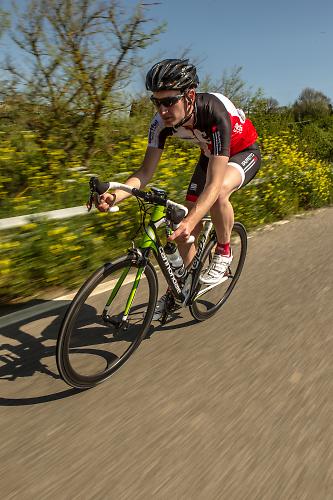

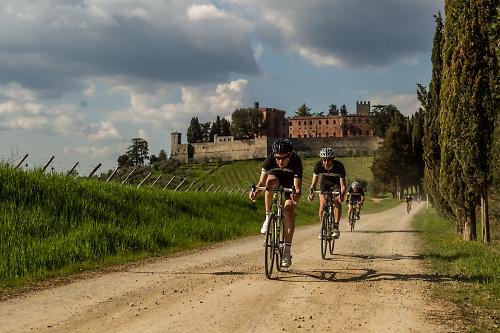

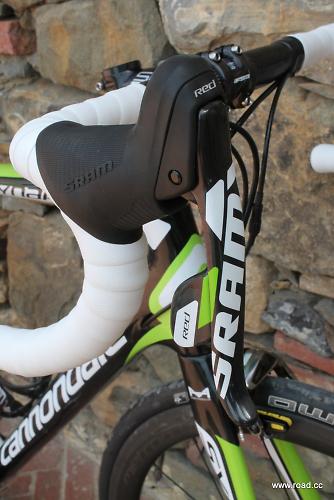




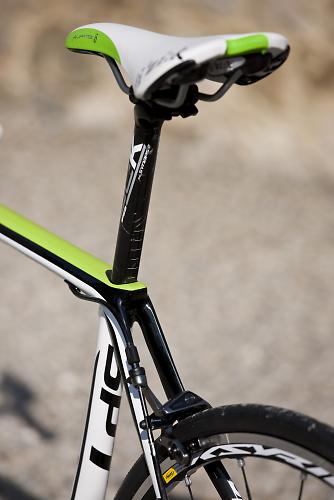




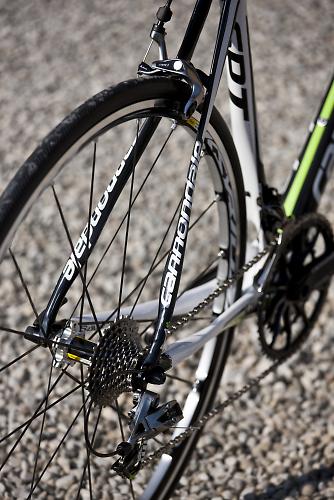

Add new comment
18 comments
It looks nice. Conventional road geometry doesn't tend to fit me well (long legs/short body), so the rise in taller/shorter fast sportive bikes gives me an option of a nice quick high-end carbon bike - if I can afford one.
Any mention from Coanondale on whether they'll be doing a disk-equipped version? Obviously Bianchi have said they are for teh Infinito CV, and BMC and Specialized already do cable-disk-equipped versions of the GF and Roubaix.
nice looking frame, you can keep the crappy Sram offering though .....
Sad to hear you didn't get on with the groupset - what was the matter with it ?
I rode l'Eroica last year on a 1987 steel Peugeot with a 105/Mavic OP wheelset shod with Schwalbe 28mm Duranos at 90psi.
I have just sold the BMC on Ebay and converted full time to this bike.
Several top new endurance bikes have been launched recently, the Cannondale Synapse HM, Bianchi Infinito CV, Ridley Fenix and of course there's the Trek Domane and Specialized Roubaix. As all these bikes are aspirational/expensive for most of us mere mortals, it would be great to see them tested in a proper 'shoot out' on UK roads where you keep the wheel/tyres combination (plus maybe seatpost/saddle) constant, so one can try to compare and gage the merits of each frame. That is still the most important question to answer I believe as most people will at some point swap/upgrade wheels and tyres anyway.
It would certainly be interesting to see it compared against a conventional road frameset, using identical 23s at the same pressure, because - whilst I'm not knocking the article (if nothing else, I'm not sure I want to be called a "miserable sod") - this bit...
"There’s the same level of vibration damping occurring no matter your position on the bike. It works when you’re seated or standing on the pedals."
...did immediately make me think, "oh, it's tyres".
Attack them Mr. Arthur! If they can't bother to read your article in its entirety you can't be held accountable for their mistakes.
Anyway, bought a 2011 Alloy Synapse this year, and it's a wonderful ride. My only issue is that I came from (literally) one of the stiffest frames of all time, so I struggle with the difference in response.
If you ride real roads, not heavenly tarmac, it's your own fault if you don't consider this bike. Eventually I'll upgrade to either a Seven frame or the Hi-mod Synapse.
Great marketing but tyres/pressure will make more difference than any frame design or material.
Pneumatic tyres are your suspension and if they can't cope with a road buzz and bumps and provide you with comfort you're doing something wrong.
28mm Ultremos or similar high end tyres (e.g. Grand Bois) run correctly at 30-40PSI less than their 23mm equivalent will not only be more comfortable but faster on most of road surfaces especially in the UK.
Comfort wise most of people don't need special "endurance" bikes but frames with sensible tyre clearance and more choice in high end 28mm, 32mm tyres, preferably tubeless.
A more open-minded approach and some recent research on tyres instead of old roadie fairy tales in popular bike magazines would help too, although with jurnos calling 28mm "fat" and expecting it to feel "sluggish" on tarmac... there's little hope...
Certainly looks to be worth a look, although a bit short on the reach. Awesome lighting feature as well.
You miserable sods
It's not meant to be an indepth review, as I said in this paragraph:
"Of course, this is just a first impression - I haven't had the chance to live with the Synapse yet and get to know it more. We’ve got our name down for one of the first demo bikes in the UK so I’ll be very keen to see how the bike's handling characteristics translate to more familiar roads."
I've ridden many titanium, aluminium, carbon and steel bikes - I rode a carbon Domane at Paris-Roubaix and the steel Stoemper at Flanders, so I have a good idea how different materials ride.
Yes, it is justifiable. It wasn't a comparison review, but a test of the bike on its own merits. My arms and arse tell me that the features do work
< This is just a ridiculous comment really. The assessment was whether it worked. It did. How it compares to other bikes wasn't obviously possible, which is why I didn't draw any conclusions
I'm happy to show you the "marketing guff" if you want, and show you this isn't "regurgitated"
I thought it was an interesting article, and somehow I wasn't confused as to whether it was an in-depth review or not.
I was also cursed by not getting my knickers in a twist because you didn't compare it with every bike in the world (especially my favourite one obviously) over the same course.
Most confusingly, I also understood what you meant when you said
.
Sad to say, it seems i'm just not cut out for reading this sort of article.
Boy, when they were first introduced I bet round wheels must have been a real, hard sell to some of the more experienced commentators here.
Hey David: my original question is a non-miserable and valid one - do you have an opinion on how this (and other) "comfort carbon" (tm) bikes ride wrt Ti bikes. I know there's quite a wide range of experiences implied there but there must be a few people out there (me included) who wonder whether this is truly the holy grail and worth an "upgrade".
I ride a Ti bike which is a lovely do-it all machine and about 7.5Kg so no slouch but I'd like to know whether I could go another direction and get more stiffness and lightness without too much loss of comfort and whether I'm better off spending my money on a new bike or new wheels.
A single opinion or review isn't going to be all I go on to form my opinion but us normals are unlikely to be able to persuade their LBS to allow them to borrow a bike like this to go on a 100km ride on dodgy roads.
Well, sorry if you felt offended by my comments, but I have to stick to my original point. I was well aware this isn't meant to be an in-depth review; that was in fact the source of my criticism. There are many statements throughout this piece that could only be justified if it had been ridden in conditions in which you knew how other bikes handled, i.e. as I would expect to be done when doing a full review. As others have pointed out, particularly when attributing certain qualities to the frame and fork themselves, the variables of wheels and tyres would also ideally need to be removed.
It's not ridiculous in the slightest. Having ridden a new bike over unfamiliar roads, one knows neither quite how well anything worked to dampen whatever vibrations that road might produce nor, if something did work, what "it" was (frame, tyres, wheels, seatpost, bar tape?). And to ascribe the bike's handling to the effectiveness of the frame & fork's response to high frequency vibrations certainly is drawing a conclusion, as are plenty of other statements, e.g. "The ... features of the frame really do seem to work."
Had I read impressions like "My arms and arse felt much better at the end of the ride than I'd have ever expected after covering roads like that," that would've been fine. But to make claims about the specific effects of a frame, in a situation where there is no comparison, defies logic. At that point it reads more like advertising hyperbole than independent journalism. I read road.cc over other sites in part because your reviews are generally a lot better than most of the other stuff I've seen, but I didn't think this article was up to your usual standard.
And I'm actually quite a cheerful sod, should you again feel it appropriate to begin any rebuttals with thoughtless insults.
I am a fan.
How does the ride of these 'comfort carbon' bikes compare to titanium framed bikes?
Who knows? Certainly not the author.
"I’ve never ridden a road bike on such roads"
"I jumped straight on to my demo bike and hit the gravel roads for the first time ever"
These first ride/launch reports are fine for getting nice pictures of a shiny new bike in a picturesque setting, but very little else.
"The ‘micro suspension’ features of the frame really do seem to work," is, for example, completely unjustifiable in the absence of any comparison.
"it’s the way the bike handles the rough gravel roads that demonstrates how effective the frame and fork are at responding to high frequency vibrations" - but how might another bike feel? You have no idea!
I know road.cc is capable of doing a decent review, so please save any statements such as the above (and there are many more in the article) for when you've ridden it in conditions which allow you to draw valid comparisons to other bikes. If you want to write a piece to whet our appetites for more info, fine. But far too much of this article reads like regurgitated marketing guff.
While I'm sure the tester has reason to feel excited by his ride on this new model, I have to agree that these first rides should be ditched unless you are testing the bike with wheels and tyres of your standard setup, how else can you dissociate what comes from the frame, wheels or 28mm tyres.
Either skip the swimming pool and lovely Italian food or wait until you've ridden the first test bike in the UK before publishing your review - I'd rather wait a couple of weeks for an informed and solid review, based on known roads and wheel/tyre combos.
"outside pedal in the 6pm position"
I prefer mine in the 6am position, YMMV.